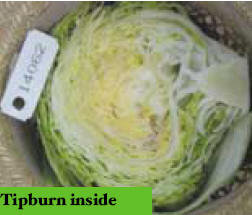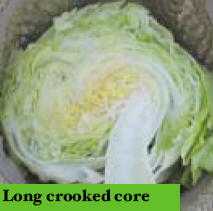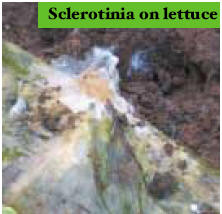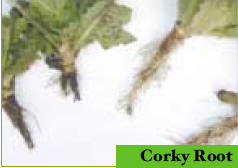Tipburn
Tipburn is the marginal collapse and necrosis, at
or near the leaf margins. The disorder can occur outside or
inside the head. Tipburn is a calcium related discorder and is
associated with low levels of calcium in leaf tissue. Warm
temperature, excessive fertilization and increase in light
intensity, and other factors that contribute to rapid growth of
lettuce, can enhance the development of Tipburn.
 Other
factors that reduce the uptake of calcium such as high salt
concentrations and high humidity can intensify the problem. Good
cultural & management practices which reduce rapid and excessive
plant growth, limit the incidence of Tipburn. Additional
applications of calcium fertilizer are generally ineffective on
crisphead lettuce. Other
factors that reduce the uptake of calcium such as high salt
concentrations and high humidity can intensify the problem. Good
cultural & management practices which reduce rapid and excessive
plant growth, limit the incidence of Tipburn. Additional
applications of calcium fertilizer are generally ineffective on
crisphead lettuce.
 Bolting
Bolting is the premature elongation of the stem,
due to premature initiation of the reproductive (flowering)
process. Head formation will be prevented and the plant will not
be harvested. Resistance to bolting is inherited, and it is
therefore possible to select appropriate varieties for climate
zones and seasons. A variety grown in the season and location
for which it was bred usually does not bolt. However, if
temperatures are higher than usual for that region, bolting can
occur. Bolting
Bolting is the premature elongation of the stem,
due to premature initiation of the reproductive (flowering)
process. Head formation will be prevented and the plant will not
be harvested. Resistance to bolting is inherited, and it is
therefore possible to select appropriate varieties for climate
zones and seasons. A variety grown in the season and location
for which it was bred usually does not bolt. However, if
temperatures are higher than usual for that region, bolting can
occur.

Downy mildew
Cause: Caused by the fungus Bremia
lactucae.: Bl. Symptoms: Light green patches develop on leaves,
which turn yellow then brown. A fluffy growth can often be seen
on the underside of the leaves below the discoloured patches.
Source of infection: The primary source of infection is from
spores in paddock debris, spores from wild lettuce weeds and
from nearby fields. Control: Use resistant varieties.
When growing a variety that is susceptible to downy mildew, the
strategic use of fungicides is the best option. Both protective
and curative (systemic) fungicides are available.
|
|
 |
Sclerotinia drop
Cause: Caused by the soil borne fungi
Sclerotinia minor and S. sclerotiorum.
 Symptoms:
The early signs of the disease are wilting and browning of
leaves followed by eventual death. Source of infection: Both
species produce hard, black reproductive survival structures
called sclerotia. These can be seen on the lower leaves
and at the base of lettuce infected by S. minor and higher in
the head when infected by S. sclerotiorum. Excess rainfall or
irrigation which results in soil moisture saturation predispose
lettuce crops to drop. Control: Rotation with non-host
crops helps in controlling both types of fungi. Drip irrigation
has also been shown to reduce levels of drop. Symptoms:
The early signs of the disease are wilting and browning of
leaves followed by eventual death. Source of infection: Both
species produce hard, black reproductive survival structures
called sclerotia. These can be seen on the lower leaves
and at the base of lettuce infected by S. minor and higher in
the head when infected by S. sclerotiorum. Excess rainfall or
irrigation which results in soil moisture saturation predispose
lettuce crops to drop. Control: Rotation with non-host
crops helps in controlling both types of fungi. Drip irrigation
has also been shown to reduce levels of drop.
Big Vein
Cause: Big Vein or Mirafiori lettuce virus: MiLV. Symptoms:
The lettuce develops leaves with large veins that appear stiff
with ruffled margins. Depending on
 the
severity of infection, some hearts will make it through to
harvest, whereas other hearts are stunted and not harvestable.
Cooler weather and low light levels favour lettuce Big Vein
development. Source of infection: The soil- borne fungus,
Olpidium brassicae spreads this virus. The fungus itself has no
effect on the lettuce crop and can survive in the soil for many
years. Control: There is no chemical control available
for Big Vein. Irrigation management to reduce water logging will
help reduce the likelihood of this disease. Where possible,
growers should use varieties that show a useful degree of
resistance. the
severity of infection, some hearts will make it through to
harvest, whereas other hearts are stunted and not harvestable.
Cooler weather and low light levels favour lettuce Big Vein
development. Source of infection: The soil- borne fungus,
Olpidium brassicae spreads this virus. The fungus itself has no
effect on the lettuce crop and can survive in the soil for many
years. Control: There is no chemical control available
for Big Vein. Irrigation management to reduce water logging will
help reduce the likelihood of this disease. Where possible,
growers should use varieties that show a useful degree of
resistance. Corky Root
Cause: Caused by the corky root bacterium,
Rhizomonas suberifaciens. Rs. Symptoms: Early symptoms of corky
root are yellow bands on tap
 and
lateral roots of lettuce seedlings. These yellow areas gradually
expand, taking on a green brown colour and developing cracks and
rough areas on the surface of the root. As disease severity
increases, the entire tap root may become brown, severely
cracked, and non-functional; the feeder root system will also be
reduced and damaged. When the root is severely diseased,
aboveground symptoms consist of wilting during warm
temperatures, stunting of plants, and general poor and uneven
growth. Control: Rotate crops out of lettuce; do not grow
lettuce consecutively. Avoid over fertilizing with nitrogen
fertilizers. Some corky root resistant cultivars are now
available. For corky root infected crops, growers may need to
add additional fertilizer and water in order to bring the crop
to maturity. High, welldraining beds may sometimes reduce corky
root severity. and
lateral roots of lettuce seedlings. These yellow areas gradually
expand, taking on a green brown colour and developing cracks and
rough areas on the surface of the root. As disease severity
increases, the entire tap root may become brown, severely
cracked, and non-functional; the feeder root system will also be
reduced and damaged. When the root is severely diseased,
aboveground symptoms consist of wilting during warm
temperatures, stunting of plants, and general poor and uneven
growth. Control: Rotate crops out of lettuce; do not grow
lettuce consecutively. Avoid over fertilizing with nitrogen
fertilizers. Some corky root resistant cultivars are now
available. For corky root infected crops, growers may need to
add additional fertilizer and water in order to bring the crop
to maturity. High, welldraining beds may sometimes reduce corky
root severity. |